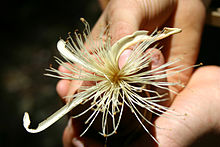| Pachira quinata | |
|---|---|

| |
| Flower showing abundance of stamens | |
| Scientific classification | |
| Kingdom: | Plantae |
| Clade: | Tracheophytes |
| Clade: | Angiosperms |
| Clade: | Eudicots |
| Clade: | Rosids |
| Order: | Malvales |
| Family: | Malvaceae |
| Genus: | Pachira |
| Species: | P. quinata
|
| Binomial name | |
| Pachira quinata | |
| Synonyms[2] | |
Pachira quinata, commonly known as pochote, is a species of flowering tree in the mallow family, Malvaceae. It inhabits dry forests in Costa Rica, Nicaragua, Honduras Panama, Venezuela, and Colombia.[2] Pochotes bear large, stubby thorns on their trunk and branches and are often planted as living fenceposts with barbed wire strung between them. These thorns are also often used to make small house-like sculptures that are believed to bring protection to someone's house since the pochote is believed to be sacred.
The tree is largely plantation grown in Costa Rica for its lumber, which is an ideal, remarkably stable hardwood similar in working properties to Cedrela odorata (Spanish cedar). It is one of the most affordable woods in Costa Rica, and is used in furniture, guitar marking, and other fine woodcrafts.
References
[edit]- ^ Sandiford (1998). "Bombacopsis quinata". IUCN Red List of Threatened Species. 1998. Retrieved 9 May 2006. Listed as Vulnerable (VU A1cd v2.3)
- ^ a b "Pachira quinata". Germplasm Resources Information Network. Agricultural Research Service, United States Department of Agriculture. Retrieved 28 May 2010.
External links
[edit] Media related to Pachira quinata at Wikimedia Commons
Media related to Pachira quinata at Wikimedia Commons Data related to Pachira quinata at Wikispecies
Data related to Pachira quinata at Wikispecies- Árboles de Centroamérica: Bombacopsis quinata (pdf Spanish)

Well, that’s interesting to know that Psilotum nudum are known as whisk ferns. Psilotum nudum is the commoner species of the two. While the P. flaccidum is a rare species and is found in the tropical islands. Both the species are usually epiphytic in habit and grow upon tree ferns. These species may also be terrestrial and grow in humus or in the crevices of the rocks.
View the detailed Guide of Psilotum nudum: Detailed Study Of Psilotum Nudum (Whisk Fern), Classification, Anatomy, Reproduction